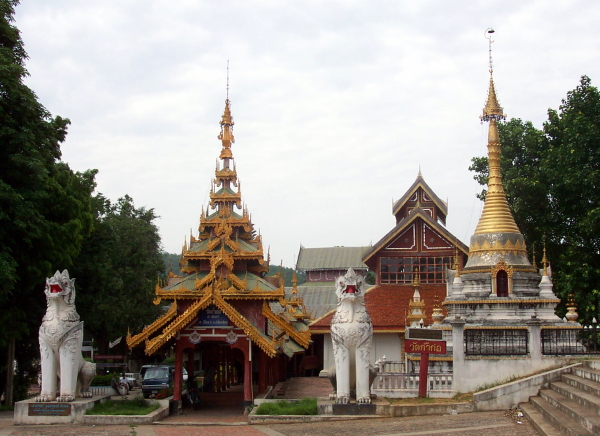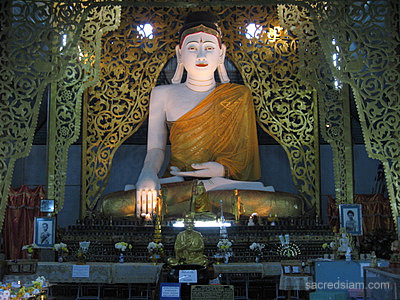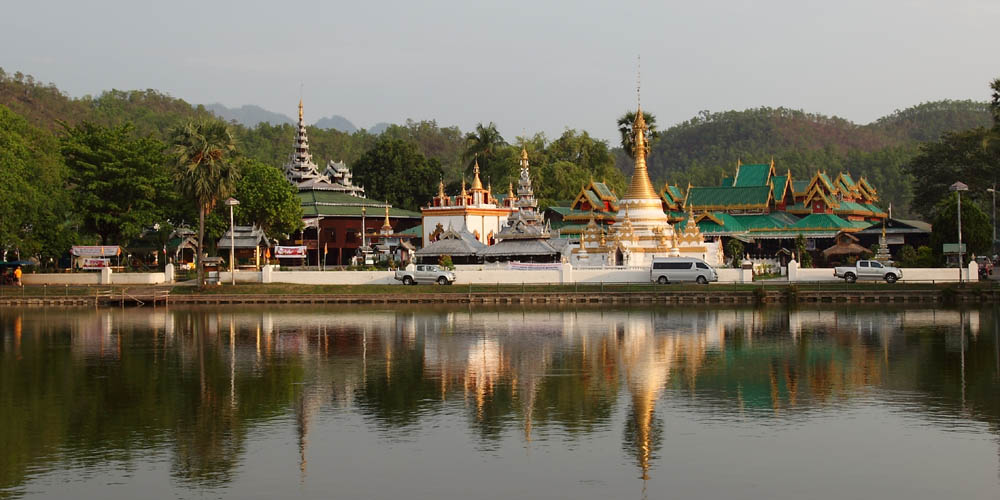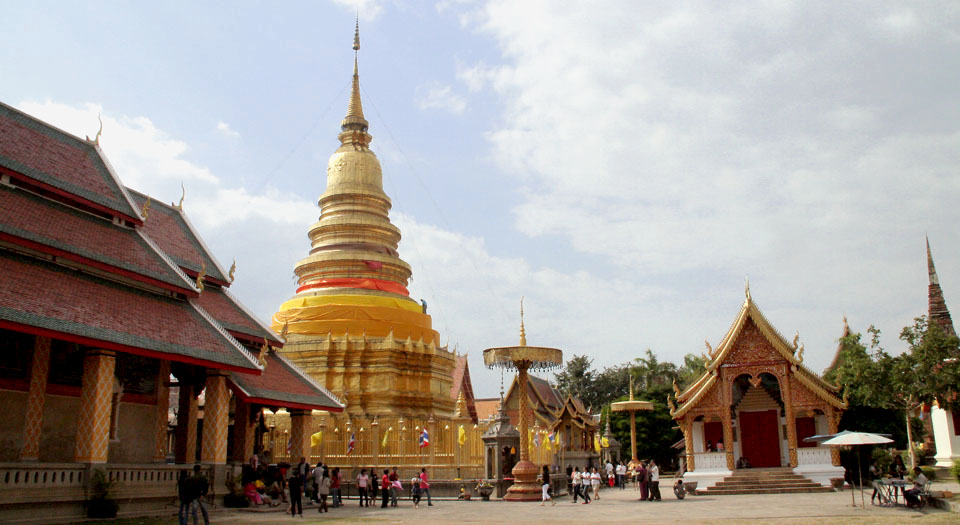A province of rich history and fertile soil, Petchabun is a province with great natural attractions; particularly its forested mountains and waterfall laden rivers that help create a climate that is cool and pleasurable nearly year round.
Despite being farther south than neighboring Loei, Phetchabun is considered part of the north than the northeast or central regions of Thailand. That said, its topography is similar to that of Loei, as Phetchabun borders three regions of Thailand, the North, Central, and Northeast. The central part of Phetchabun province is in the Pa Sak River basin and contains mountain ranges running along both the western and eastern sectors. Because of the fertility of the land, Phetchabun has always been an agriculturally productive area. The very name of the province derives from a name meaning “the land of crops and foods.” Today, Phetchabun is a province with rich tourism potential. Its climate is pleasant due to the mountainous and forested areas, and it has a rich history dating back more than 1,400 years.
Phetchabun is a province of rich tourism potential with attractions including Khao Kho National Park, which has been referred to as "Little Switzerland" because of its beautiful scenery and cool weather; Nam Nao National Park, which features a large number of wild animals that can be spotted while trekking; and Than Thip Waterfall, which is a popular place for swimming.Phetchabun also features a rich history dating back more than 1,400 years, the height of which occurred after the 11th century when the city was a point of contact between the Dvaravati and Khmer Empires. The city was a prosperous center and a number of ruins remain for visitors to appreciate at Si Thep Historical Park.
Khao Kho
Late winter is not the high season for Khao Kho. However, there are some advantages. The annoying rains become less frequent and the temperature is not too cold. The charm of the woods, the scenery and the other attractions on the mountain still remain for sightseeing drives. Additionally, at this time of the year, flowers in Non Son field of Thung Salang Luang national park and plenty of cool-climate plants give a high yield to welcome all tourists.
Due to the overlapping boundary of Khao Kho and Thung Salang Luang National Park, arranging a mutual itinerary is possible. Tourists may pitch a tent or find shelter at Thung Nang Praya ranger unit and then drive to Khoa Kho Mountain. Alternatively, one may opt to stay in the resorts on Khao Kho Mountain and drive to the lovely pine forest at Thung Nang Praya.
Here is a list of preparations before a trip to Khao Kho for those who get there using their own transport. Most routes to Khao Kho climbing the mountain are considerably steep, thus a thorough car inspection, especially the brakes, is vital. Moreover, it is better to fill up the gas tank before departure because most petrol stations are only located around Khaem Son T-junction.
Outstanding tourist attractions for late winter are chiefly blooming cool-climate flowers and color-changing leaves. Even the green savannah is also ready to turn gold when the summer arrives. This place is perfect for couples to go sightseeing, arrange their wedding ceremonies, or honeymoon, as romantic atmosphere – fine weather and bright blue skies – are everywhere. Nearby attractions include the Noen Mahatsachan (or mysterious hill) and the scenic point for agricultural products where there are great blends of hot coffee waiting for you to try. Drive a bit further to Khao Kho palace and climb up Khao Ya to visit the armory museum, Khao Kho sacrificial monument, the international library, and Kanchana Pisek grand pagoda. Finally, end this amazing trip by watching the sunset at Ratta-nai reservoir and Sri-dit waterfall, which is said to be the most beautiful waterfall on Khao Kho, along with Bang Rachan islet – the one and only place in Thailand where freshwater jellyfish can be found.
How to get there
Although Khao Kho is situated in Petchaboon, many tourists rather go via highway No. 12 (Pitsa Nulok – Lomsak). This is because of breath-taking views and a number of tourism locations along the road to stop at for both natural beauty and enjoyment. Keep driving until you reach the 100th milestone (Khaem Son – Khao Kho junction) which is considered the green route to Khao Kho with amazing sceneries and attractions.
Kang Krachan
Kang Krachan National Park; Thailand’s largest conserved forest, is not only a heaven on earth for nature lovers, but also gains high popularity among campers looking to experience a dazzling sea of mist.
Kang Krachan forest is considered the nearest national park from Bangkok – less than 200 kilometers – to witness mountain mist almost similar to the ones in the northern hills. Tourists can camp overnight at Kang Krachan National Park unit (Mt. Phanern Tung) until before the sun rises, then they hike to the viewpoint around the 31st kilometer post. The landscape of broad valleys entirely covered by a sea of fog appears at the breaking of dawn. Later, the mist vanishes and gradually reveals endless perspectives of thick woods and overlapping mountain ranges.
Due to the fertility of Kang Krachan forest, there are a large number of visitors coming here for bird watching, butterfly watching or plant studies especially at the other camping sites, Ban Krang national park unit.
Good to see
Kang Krachan lake, a massive reservoir made from the earth filled dam of Petchburi river, is an enchanting tourism location where visitors can get on a boat to enjoy cataracts and surrounding views. Accommodation is available at the official residences of Kang Krachan National Park or otherwise camp by the lake.
Good to try
Fish from the dam are strongly recommended. Along Kang Krachan Lake, several restaurants offering mouth-watering dishes cooked from freshwater fish–catfish, feather backs, gobies, etc in a breezy riverside atmosphere.
Good to buy
It could not be anything but custard pudding. Authentic Petchburi custard puddings come without fried shallots on the top. Velvety smooth custard puddings are served in small trays and available in a variety of flavors.
Pha Daeng
Pha Daeng Wild Life Reserve, Lom Sak district, Petchaboon province is a beautiful natural attraction with a well-known viewpoint. From the overhanging rock viewpoint 200 meters from the parking area, it is possible to see the forest at Nam Naw and Highway 12 as it cuts through the woodland. On a clear day, you may see Kor Mountain in the distance. For flower and orchid lovers the area around Pha Daeng has some rare orchids in various colors.
For those who want to stay over, there is a camping area in Pha Daeng Wild Life Reserve Area Office but you have to bring your own food and drinks. However, most tourists like to go to stay at Nam Naow national park which is about 25 kilometers away as it is more comfortable and in the morning, you can drive to visit many interesting places in Nam Naow national park.
Travel Information
From Lom Sak district, take highway no.12 (Lom Sak – Khon Kaen) to Chum Pae district. At the kilometer 18.5, cross Pho Khun Pha Mueng bridge and go straight on for about 4 kilometers. At the junction, turn left to Pha Daeng Wild Life Reserve Area Office which is about three kilometers distant.
Travel Season winter and summer
Facilities
You can camp in the area provided at Pha Daeng Wild Life Reserve Area Office or stay in Nam Naow national park which is not too far away. From Highway no.12 (Lom Sak – Khon Kaen) pass Pho Khun Pha Mueng Bridge, you will see Pha Daeng. Then turn left, go straight about 3 kilometers to arrive at Pha Daeng Wild Life Reserve Area Office.
Mrigadayavan Palace, the Elegant Diamond of Cha-am Beach
“The Palace of Love and Hope” is on the coast of Cha-am Beach, Phetchaburi Province facing the sea. King Rama VI ordered Hat Chao Samran Palace to be demolished and built the Mrigadayavan Palace. The construction was finished in 1925. There was a diverse range of animals around the palace especially deer therefore, the king announced this palace would be an animal sanctuary named Mrigadayavan Palace which means the land of deer.
Mrigadayavan Palace is made of golden teak in the western style. There are three connecting thrones. The three thrones are Samut Phiman Hall (the throne of King Rama VI including a big building with bedrooms, dressing rooms, work room, bathrooms, dining rooms, and the Queen Suwattana’s room), Phisan Sakon Hall (the ladies ’ quarter) and Samoson Sewakamat Hall (the theater and rendezvous). There are sea views from each of the throne rooms.
Mrigadayavan Palace is looked after by the Foundation of Mrigadayavan Palace under Her Royal Highness Princess Bejaratana. The palace was built with the aim to match the landscape and climate. The high ceilings of the building provide ample sunlight and sea breezes. The ceilings were made of reinforced concrete to be strong and wind resistant.
After the end of King Rama VI era, the palace was deserted for about forty years. It took eleven years to renovate and restore the palace to its former glory.
Around Mrigadayavan Palace, there are the projects of the King and the royal family such as Huay Sai Development Study Center (the King’s project), Hub Kapong (the Queen’s Project), Herb Garden (the King Mother’s project), and Sirindhorn Park.
Mrigadayavan Palace Rama VI Camp, Huay Sai Nua Sub-district Cha-am District, Phetchaburi Province Contact No. 0-3247-1388 www.phetchaburi.go.th/data/praram.htm
Wat Phra That Pha Kaew
History
Established in 2004, Wat Phra That Pha Kaew at that time was called Pha Sorn Kaew holy Buddhist site until The Sangha Supreme Court approved raising the standing to a temple on July 1, 2010. The abbot of is Phra Kru Ajarn Sangkaruk Paramita Surayudtho.
The temple is located at Thang Daeng village hill’s holy place, Camp Son sub district, Khao Kho district, Phetchabun. Faith drove Ms Phawinee and Ms Urai Chotikul to purchase 25 rai land and offer it to the monastery as a Dharma retreat. This place can be used by both monks and Buddhist followers. Currently, the land has expanded to 95 rai as a sacred offering from devotees.
Phra Kru Ajarn Sangkaruk Paramita Surayudtho and Phra Kru Bai Deeka Amnard Opaso, by virtue of friendship, collaborate with followers and people with good faith from all over country to establish accommodation and a preaching hall, provided for the influx of the Lord Buddha’s Foundation of Mindfulness practitioners coming constantly to this holy place. It is now a flourishing center for the contemplation, study and practice of the Dharma much to the delight of all involved.
The Buddhist centre called Pha Sorn Kaew is surrounded by high mountains. There the preaching hall is located while a cave is at mountain’s summit. Many Thang Daeng villagers have seen a crystal marble floating on the horizon and disappearing in the cave. They believe that the marble, in fact, is the Holy Relic coming down to the sacred place, so Phra Sorn Kaew, the hidden cliff of marble. This Buddhist site surrounded by mountain ranges is a peaceful place to withdraw and contemplate the deeper teaching and practice of Buddhism.
Purpose
This temple exists with an intention to be a place for the Foundation of Mindfulness practice, which is a core Buddhist principle. This teaching is the great path to purity of body and mind, extinguishment of sorrow the Noble Eightfold path and Nirvana achievement in accordance with Buddhist doctrine.
Solitary and surrounded by gorgeous nature, meditation is inspired by natural beauty. Bliss brings contemplation and meditation gives rise to wisdom. Because all dharma arises from causes and conditions, Wat Phra Sorn Kaew originates from this perspective.
Buddhist practice
The heart of Buddhist practice is taught here. The Foundation of Mindfulness emphasizes simplicity in order to perceive awareness, from the concrete body to emotion and mind called abstract that stays constantly human. The main practice teaching of this place stresses the Foundations of Mindfulness experience to adapt for everyday use for peaceful coexistence.
Nam Nao National Park
Highway No.12 (Lom sak - Khon Kaen) is one of the most wonderful routes because there are several tourist attractions along the road that you can visit along the way. Let us begin with the 18.5 kilometer post to Nam Nao National Park via Pho Khun Pha Mueang bridge. This route is a high quality macadamized road with many fine restaurants.Nam Nao National Park covers Muang, Lom Sak and Lom Kao districts in Petchaboon, as well as Klong San district in Chaiyabhum. It is regarded as one of the most fascinating national parks in Thailand. The national park acts as a border between the northeastern and northern parts of the country with its general topography that comprises high mountain ranges. It is home to untouched forests, streams and beautiful landscapes. It sweeps over an approximate area of 996 square kilometers or 603,750 Rai.
Even though most of the natural attractions; for instance, caves, dazzling pine tree gardens or waterfalls are located outside the national park, they are not too far and easy to reach there by car. To get to Pha Hong cave at the 39 kilometer post, take Highway No. 12 (Lom sak – Chum pae). Phu Kum Khao pine tree garden is located at the 53 kilometer post on Highway No. 12 (Lom sak- Chum phae). Heaw Sai waterfall is at the 67 kilometer post and the same highway (Lom sak- Chum phae) can take you there. However if you keep driving for another 500 meters, you will come to Sai Thong waterfall. Finally, Mt. Phaa Jit (Mt. Dan Ei Pong) is situated at the 69 kilometer post on Highway No. 12 (Lom sak- Chum phae).













































